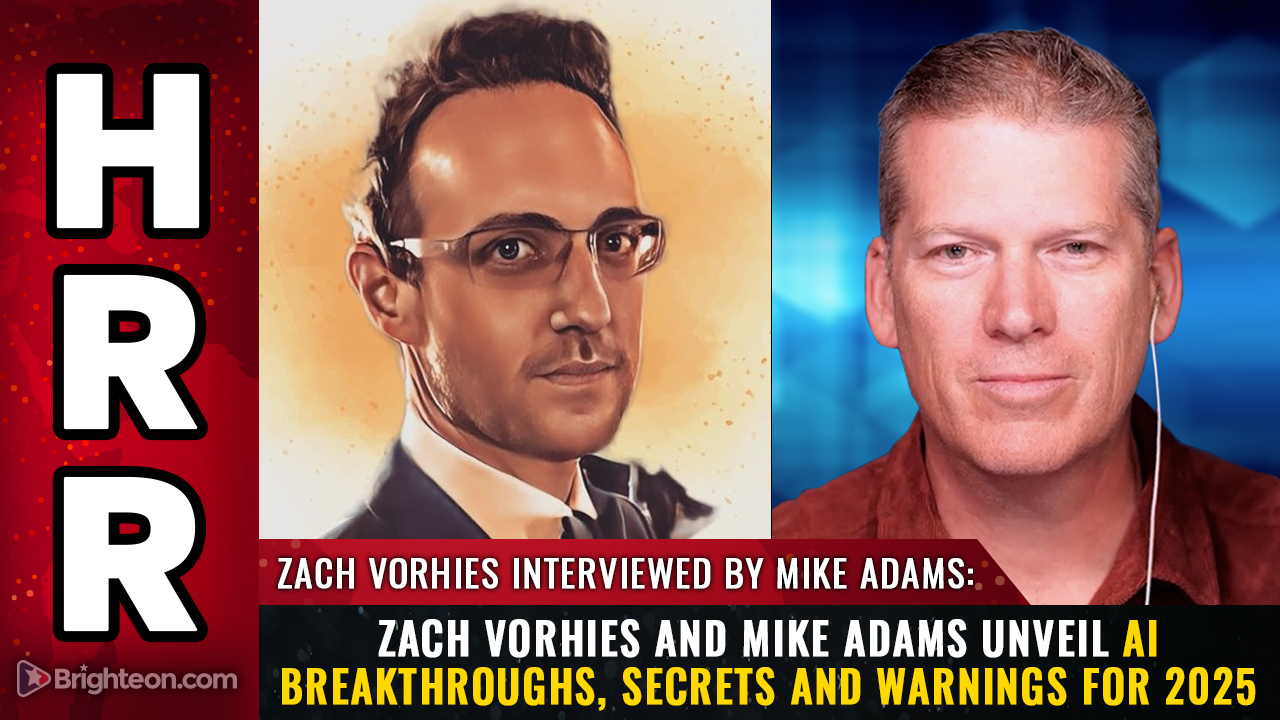AI Breakthrough: Mike Adams and Zach Vorhies discuss open AI’s soft AGI milestone, surpassing human capabilities in complex problem-solving
01/22/2025 / By Finn Heartley

- OpenAI has developed a “soft AGI” system, achieving a 20% completion rate on the ARC AGI test, surpassing the average human PhD score of 18%, signaling a leap in AI problem-solving capabilities.
- AGI could outperform humans in innovation, invention, and space exploration, potentially replacing human roles in coding, journalism, and other fields, elevating humans to more strategic, creative positions.
- Running advanced AGI models requires massive energy, with costs per question equivalent to a year’s energy for an individual, though hardware advancements may improve efficiency in the future.
- The race to superintelligence is likened to an arms race, with nations like China posing a threat due to their energy and manufacturing superiority, urging Western nations to accelerate AI development.
- AGI’s rapid advancement raises concerns about human relevance and societal bifurcation, emphasizing the need for proactive adaptation to avoid being left behind in an AI-dominated future.
In a groundbreaking development, OpenAI has announced the creation of a “soft AGI” (Artificial General Intelligence) agent, marking a significant leap in AI capabilities. This AGI system scored a 20% completion rate on the ARC AGI test, a benchmark designed to evaluate novel problem-solving abilities, surpassing the average human PhD score of 18%. The implications are profound: AGI systems could soon outperform humans in innovation, invention, and even space exploration. However, concerns about energy consumption and the potential for AI to recursively improve itself raise questions about the future of human relevance in a world dominated by superintelligent machines.
In a recent interview on Brighteon.com, Mike Adams, the Health Ranger, and Zach Vorhies, the Google whistleblower and AI expert, delved into the implications of this milestone and what it means for humanity.
The Soft AGI Revolution
Zach Vorhies described the recent OpenAI announcement as a “wake-up call” for the tech community. AGI, or Artificial General Intelligence, represents the holy grail of AI development—a machine capable of outperforming humans in virtually any intellectual task. “Once you have AGI, you have a machine that is smarter than any other person on the planet combined,” Vorhies explained. “You can make millions or billions of them sitting in a data warehouse, coming up with inventions, patents, and innovations.”
The ARC AGI test, which OpenAI’s model aced, is particularly significant because it evaluates an AI’s ability to solve novel problems—something that has historically been a weak point for large language models (LLMs). Vorhies noted that OpenAI’s model achieved a 20% completion rate, surpassing the average human PhD score of 18%. “This is a revolutionary performance metric,” he said.
Energy Consumption and the AI Arms Race
While the achievement is remarkable, it comes with a hefty price tag. Vorhies highlighted the staggering energy costs associated with running these advanced models. “The amount of energy required per question is between 1,000 and 5,000,” he said. “That’s like a year’s worth of energy for someone living in a place where energy is cheap.”
However, Vorhies remains optimistic about the future of energy efficiency in AI. He pointed to advancements in hardware, such as Nvidia’s new Blackwell processor, which promises a 1,000x increase in compute power. “The cost of general AI has fallen by a factor of 1,000 in the last two years,” he said. “I expect these AGI issues will also require 1,000th of the amount of energy in the coming years.”
The Future of Work and Human Relevance
The rise of AGI raises critical questions about the future of work and human relevance. Vorhies and Adams discussed how AI agents could soon replace human workers in various fields, from coding to journalism. “The future is not going to be human coding,” Vorhies said. “It’s going to be humans specifying what they want to have done, and then AI agents doing it.”
Adams added that AI could elevate human roles to more creative and strategic positions. “Coders need to change their role to be more of the architects of coding,” he said. “Journalists need to be architects of stories, not typists.”
However, Vorhies warned that the rapid advancement of AI could lead to a bifurcation of society. “We’re quickly becoming a bunch of worthless eaters with this new AI tech,” he said. “The only way to escape that is to start using artificial intelligence now. If you don’t use it, you’re going to be left behind.”
The Geopolitical Implications of AGI
The conversation also touched on the geopolitical implications of AGI. Vorhies and Adams agreed that the race to superintelligence is akin to an arms race, with nations and corporations vying for dominance. “Whoever gets to superintelligence first will have a massive advantage,” Adams said.
Vorhies pointed to China’s rapid advancements in AI and manufacturing as a significant threat to Western dominance. “China has energy superiority and manufacturing superiority,” he said. “If we don’t want to get exterminated by China, we’re going to need to lay down 10x or 100x more power than we currently have.”
Conclusion: A Brave New World
The development of soft AGI marks a pivotal moment in human history. While the potential benefits are immense—ranging from groundbreaking scientific discoveries to unprecedented economic growth—the risks are equally significant. As Vorhies put it, “This train has no brakes.”
The challenge for humanity will be to navigate this new era with wisdom and foresight, ensuring that the power of AGI is harnessed for the greater good rather than leading to societal collapse or global conflict. As Adams concluded, “Not all the humans alive today are going to navigate this. The number one thing is that you be prepared for what’s coming.”
For now, the world watches with bated breath as the soft AGI revolution unfolds, reshaping the very fabric of human existence.
Watch this full episode of the “Health Ranger Report” with Mike Adams, the Health Ranger, and Zach Vorhies as they unveil AI breakthroughs, secrets and warnings for 2025.
This video is from the Health Ranger Report channel on Brighteon.com.
More related stories:
AI, AI and even more AI: Nvidia announces projects and products lined up for 2025
Sources include:
Submit a correction >>
Tagged Under:
AI, AI advancements, AI cost, AI judges, architect AI, breakthrough, Brighteon Broadcast News, Collapse, compute hardware, context windows, cyborg, decentralized technology, energy dominance, energy efficiency, future tech, glitch, implementer AI, interviews, inventions, large language models, Mike Adams, novel problems, pensions, policy solutions, recursive feedback, robotics, soft AGI, Special Report
This article may contain statements that reflect the opinion of the author
RECENT NEWS & ARTICLES
COPYRIGHT © 2017 PENSIONS.NEWS
All content posted on this site is protected under Free Speech. Pensions.news is not responsible for content written by contributing authors. The information on this site is provided for educational and entertainment purposes only. It is not intended as a substitute for professional advice of any kind. Pensions.news assumes no responsibility for the use or misuse of this material. All trademarks, registered trademarks and service marks mentioned on this site are the property of their respective owners.




















